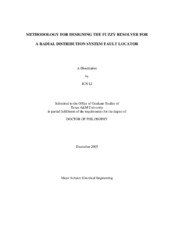| dc.description.abstract | The Power System Automation Lab at Texas A&M University developed a fault location scheme that can be used for radial distribution systems. When a fault occurs, the scheme executes three stages. In the first stage, all data measurements and system information is gathered and processed into suitable formats. In the second stage, three fault location methods are used to assign possibility values to each line section of a feeder. In the last stage, a fuzzy resolver is used to aggregate the outputs of the three fault location methods and assign a final possibility value to each line section of a feeder. By aggregating the outputs of the three fault location methods, the fuzzy resolver aims to obtain a smaller subset of line sections as potential faulted sections than the individual fault location methods. Fuzzy aggregation operators are used to implement fuzzy resolvers. This dissertation reports on a methodology that was developed utilizing fuzzy aggregation operators in the fuzzy resolver. Three fuzzy aggregation operators, the min, OWA, and uninorm, and two objective functions were used to design the fuzzy resolver. The methodologies to design fuzzy resolvers with respect to a single objective function and with respect to two objective functions were presented. A detailed illustration of the design process was presented. Performance studies of designed fuzzy resolvers were also performed. In order to design and validate the fuzzy resolver methodology, data were needed. Due to the lack of real field data, simulating a distribution feeder was a feasible alternative to generate data. The IEEE 34 node test feeder was modeled. Time current characteristics (TCC) based protective devices were added to this feeder. Faults were simulated on this feeder to generate data. Based on the performance studies of designed fuzzy resolvers, the fuzzy resolver designed using the uninorm operator without weights is the first choice. For this fuzzy resolver, no optimal weights are needed. In addition, fuzzy resolvers using the min operator and OWA operator can be used to design fuzzy resolvers. For these two operators, the methodology for designing fuzzy resolvers with respect to two objective functions was the appropriate choice. | en |


